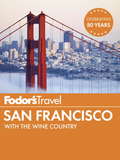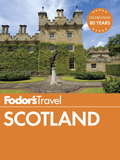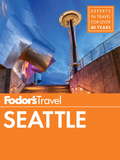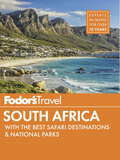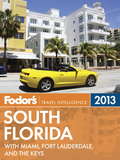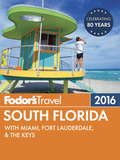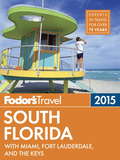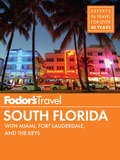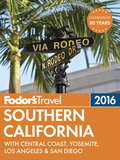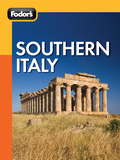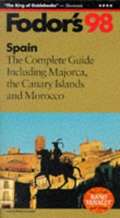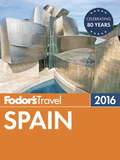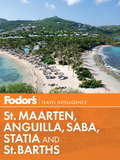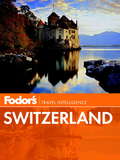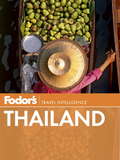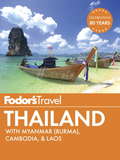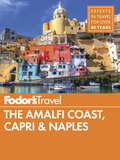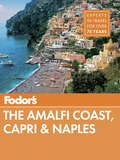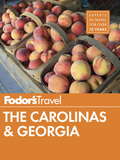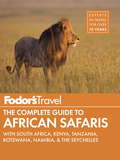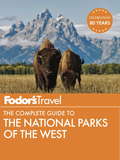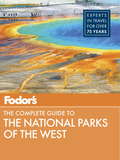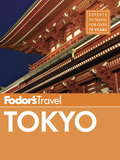- Table View
- List View
Fodor's San Francisco: with the Best of Napa & Sonoma
by Fodor'sFodor's correspondents highlight the best of San Francisco, including Chinatown's dim sum spots, Pacific Heights' Victorian homes, and the scenic wonder of the Golden Gate Bridge. Our local experts vet every recommendation to ensure you make the most of your time, whether it's your first trip or your fifth. MUST-SEE ATTRACTIONS from the Ferry Building to Alcatraz PERFECT HOTELS for every budget BEST RESTAURANTS to satisfy a range of tastes GORGEOUS FEATURES on cable cars and vineyard escapes VALUABLE TIPS on when to go and ways to save INSIDER PERSPECTIVE from local experts COLOR PHOTOS AND MAPS to inspire and guide your tripthings to do, and what to do with kids make it easy to plan a vacation. Best Bets charts for restaurants and hotels; easy-to-read color neighborhood maps; and tips on how to get around give easy access to the best of San Francisco. DISCERNING RECOMMENDATIONS: Fodor's San Francisco offers savvy advice and recommendations from seasoned updaters to help travelers make the most of their time. Fodor's Choice designates our best picks, from hotels to nightlife. INCLUDES: Union Square, Mission District, Castro, Chinatown, North Beach, Nob Hill, Golden Gate Park, Wine Country, and more. ABOUT FODOR'S AUTHORS: Each Fodor's Travel Guide is researched and written by local experts.
Fodor's Scotland
by Fodor'sScotland offers astonishing variety: its iconic lochs and mountains, as well as lively cities such as Edinburgh and Glasgow, have strong allure. Visitors from North America increased 28% in 2014, to over 500,000. St. Andrews is a pilgrimage for golfers; castles dot the country; and whisky distilleries are gaining popularity. Scotland's customs and products--from tartans to tweeds--are known worldwide, but there's nothing like experiencing them firsthand.From the Trade Paperback edition.
Fodor's Seattle
by Fodor'S Travel GuidesWritten by locals, Fodor's travel guides have been offering expert advice for all tastes and budgets for more than 80 years. Seattle is a city of many personalities: eclectic, urban, outdoorsy, artsy, gritty, down-to-earth, or posh--it's all here, from the quirky character of the Seattle Waterfront, to the eccentric "Republic of Fremont," to hipsters walking baby carriages past aging mansions on Capitol Hill. There's something for just about everyone within this vibrant Emerald City. Outside of Seattle, the San Juan Islands offer a respite from city life, while Mt. Rainier, Mt. St. Helens, and Olympic National Park beckon adventure travelers.This travel guide includes:· Dozens of full-color maps· Hundreds of hotel and restaurant recommendations, with Fodor's Choice designating our top picks· Multiple itineraries to explore the top attractions and what’s off the beaten path· Coverage of Pike Place Market, the Space Needle, Chihuly Garden and Glass, Ballard's restaurants and bars, Olympic Sculpture Park, the Puget Sound Islands, Mt. Rainier, Olympic National Park, and the San Juan Islands.Planning to visit more of the Pacific Northwest? Check out Fodor's travel guide to the Pacific Northwest with Oregon, Washington & Vancouver.
Fodor's South Africa
by Fodor'sFodor's correspondents highlight the best of South Africa, including vibrant Cape Town and Johannesburg, the beautiful Cape Winelands, and Kruger National Park. Our local experts vet every recommendation to ensure you make the most of your time, whether it's your first trip or your fifth. MUST-SEE ATTRACTIONS from Cape Point to the Kalahari PERFECT HOTELS for every budget BEST RESTAURANTS to satisfy a range of tastes useful FEATURES on safaris and South African history VALUABLE TIPS on when to go and ways to save INSIDER PERSPECTIVE from local experts COLOR PHOTOS and maps to inspire and guide your triprecommended tour companies, helpful itineraries to make the most of your time, and more assist a wide range of travelers. DISCERNING RECOMMENDATIONS: Fodor's South Africa offers savvy advice and recommendations from local writers to help travelers make the most of their time. Fodor's Choice designates our best picks, from hotels to nightlife. INCLUDES: Cape Town, Johannesburg, Durban, the Garden Route, Kruger National Park, the Winelands, Victoria Falls, and more. ABOUT FODOR'S AUTHORS: Each Fodor's travel guide is researched and written by local experts.
Fodor's South Florida 2013
by Fodor'sWith many of the state's most popular destinations, including Miami, Palm Beach, Fort Lauderdale, the Everglades, and the Florida Keys, South Florida is a vacation destination rich in possibilities for every kind of traveler. Filled with color photos and fabulous maps, Fodor's South Florida is easier to browse than ever.Competitive Advantage: Fodor's South Florida is the only annual guide to the region.Expanded Coverage: From top to bottom, this edition of Fodor's South Florida has been completely revised and reorganized, with more nightlife in Fort Lauderdale, more focused coverage of Palm Beach and the Treasure Coast, improved coverage in Miami, and better hotel and restaurant selections throughout the region.Indispensable Trip Planning Tools: An "Experience South Florida" chapter covering what's new in the region, great itineraries, helpful tips on getting there and around, and much more helps readers choose their perfect Florida trip.Discerning Recommendations: Fodor's South Florida offers savvy advice and recommendations from local writers to help travelers make the most of their time. Fodor's Choice designates our best picks, from hotels to nightlife. "Word of Mouth" quotes from fellow travelers provide valuable insights.TripAdvisor Reviews: Our experts' hotel selections are reinforced by the latest customer feedback from TripAdvisor. Travelers can book their Florida stay with confidence, as only the best properties make the cut.
Fodor's South Florida 2014
by Fodor'sWith many of the state's most popular destinations, including Miami, Palm Beach, Fort Lauderdale, the Everglades, and the Florida Keys, South Florida is a vacation destination rich in possibilities for every kind of traveler. Filled with color photos, eye-popping features and fabulous maps, Fodor's South Florida is easier to browse than ever. New Coverage: From top to bottom, this edition of Fodor's South Florida has been completely revised, with new hotels and restaurants in Fort Lauderdale, Miami, and Palm Beach. Additional nightlife and dining choices have been added to the Florida Keys. Illustrated Features: Special "In Focus" sections throughout the book illuminate the most distinctive features of South Florida. Art Deco Miami, Snorkeling & Scuba Diving, Everglades Ecosystems, and more give travelers an unparalleled sense of South Florida. Indispensable Trip Planning Tools: An "Experience South Florida" chapter covering what's new in the region, great itineraries, helpful tips on getting there and around, and much more helps travelers choose their perfect Florida trip. Each city or regional chapter opens with four pages that include a map, "Top Reasons to Go" and other essential information to help visitors plan time and vacation details effectively. Competitive Advantage: Fodor's South Florida is the only full-color annual guide to the region. Discerning Recommendations: Fodor's South Florida offers savvy advice and recommendations from local writers to help travelers make the most of their time. Fodor's Choice designates our best picks, from hotels to nightlife. "Word of Mouth" quotes from fellow travelers provide valuable insights. ABOUT FODOR'S AUTHORS: Each Fodor's Travel Guide is researched and written by local experts.
Fodor's South Florida 2015
by Fodor'sFodor's correspondents highlight the best of South Florida, including Miami's Art Deco District, Key West's Mallory Square, and Fort Lauderdale's lively beaches. Our local experts vet every recommendation to ensure you make the most of your time, whether it's your first trip or your fifth. MUST-SEE ATTRACTIONS from Palm Beach to the Florida Keys PERFECT HOTELS for every budget BEST RESTAURANTS to satisfy a range of tastes GORGEOUS FEATURES on snorkeling and the Everglades VALUABLE TIPS on when to go and ways to save INSIDER PERSPECTIVE from local experts COLOR PHOTOS AND MAPS to inspire and guide your trips, helpful tips on getting there and around, and much more helps travelers choose their perfect Florida trip. Each city or regional chapter opens with four pages that include a map, "Top Reasons to Go," and other essential information to help visitors plan time and vacation details effectively. DISCERNING RECOMMENDATIONS: Fodor's South Florida offers savvy advice and recommendations from local writers to help travelers make the most of their time. Fodor's Choice designates our best picks, from hotels to nightlife. INCLUDES: Miami, Fort Lauderdale, Broward County, Palm Beach, the Treasure Coast, Key West and the Florida Keys, and the Everglades. ABOUT FODOR'S AUTHORS: Each Fodor's Travel Guide is researched and written by local experts.
Fodor's South Florida: with Miami, Fort Lauderdale & the Keys
by Fodor'S Travel GuidesWith many of the state's most popular destinations, including Miami, Palm Beach, Fort Lauderdale, the Everglades, and the Florida Keys, South Florida is a vacation destination rich in possibilities for every kind of traveler. Filled with color photos, eye-popping features and fabulous maps, Fodor's South Florida is easier to browse than ever.
Fodor's Southern California 2013
by Fodor'sBeautiful beaches, perfect weather, movie-star glamour...there are so many reasons to visit Southern California that deciding where to go and what to do can be a bit overwhelming. Fodor's Southern California 2013 takes the guesswork out of choosing the perfect SoCal experiences--from picking the perfect Santa Barbara bistro to finding the best studio tour in Hollywood. This guide is filled with advice and tips from our team of local writers, making it as indispensable as a tube of SPF 30.Competitive Advantage: The only annually updated guidebook to Southern California.Discerning Recommendations: Fodor's Southern California offers savvy advice and recommendations from local writers to help travelers make the most of their time. Fodor's Choice designates our best picks, from hotels to nightlife. "Word of Mouth" quotes from fellow travelers provide valuable insights.TripAdvisor Reviews: Our experts' hotel selections are reinforced by the latest customer feedback from TripAdvisor. Travelers can book their California stay with confidence, as only the best properties make the cut.
Fodor's Southern Italy
by Fodor'sGet inspired and plan your next trip with Fodor's ebook travel guide to Southern Italy.Intelligent Planning: Discover all of the essential, up-to-date details you expect in a Fodor's guide, including Fodor's Choice dining and lodging, top experiences and attractions, and suggested itineraries. Easy Navigation for E-Readers: Whether you're reading this ebook from start to finish or jumping from chapter to chapter as you develop your itinerary, Fodor's makes it easy to find the information you need with a single touch. In addition to a traditional main table of contents for the ebook, each chapter opens with its own table of contents, making it easy to browse. Full-Color Photos and Maps: It's hard not to fall in love with southern Italy as you flip through a vivid full-color photo album. Explore the layout of city centers and popular neighborhoods with easy-to-read full-color maps. Plus, get an overview of Italian geography with the convenient atlas at the end of the ebook.Bonus Reading for the Love of Italy: In addition to the quintessential travel tips you expect in a Fodor's guide, we've included three excerpts from exceptional books about Italy. Immerse yourself in Italy with cultural insights from these top-selling authors:Beppe Severgnini (LA BELLA FIGURA)Joseph Bastianich and David Lynch (VINO ITALIANO)Arthur Schwartz (THE SOUTHERN ITALIAN TABLE)Explore Southern Italy: The region of Campania is a popular place both to unwind on the pint-size island of Capri or the resort towns of the Amalfi Coast and to explore the past at the archaeological ruins of Pompeii, Herculaneum, and Paestum. In the middle of everything is the vibrant, chaotic city of Naples. Farther south, in the off-the-beaten-path regions of Puglia, Basilicata, and Calabria, you'll find attractive beaches, mysterious ancient dwellings, and the charming town of Lecce. Across a narrow straight from Calabria is Sicily. Baroque church-hopping could be a sport on the cacophonous streets of Palermo and Siracusa, and amid the almond groves of Agrigento stands one of the world's best-preserved Greek ruins. Note: This ebook edition includes photographs and maps that will appear on black-and-white devices but are optimized for devices that support full-color images.
Fodor's Spain '98
by Alison B. SternThe best guide to Spain, updated every year. Bullfights, pageants, festivals, and flamenco. Great walks in cities and towns and drives in the country. Shopping for beautiful embroidery and lace and the finest Spanish leather and country-style ceramics. Lively nightlife, from tapas bars to teatrosto jazz clubs. Side trip to Morocco, with best bets for short stays. Where to stay and eat, no matter what your budget. Paradors, mountain retreats, resorts, and historic inns. Posh restaurants and cafés, plus top picks for paella. Fresh, thorough, practical-- off and on the beaten path Costs, hours, descriptions, and tips by the thousands. All reviews based on visits by savvy writer-residents. 40 vacation itineraries, and more. Important contacts and smart travel tips. Fodor's Choice What's Where, Pleasures & Pastimes, New & Noteworthy, background essays, and a complete index.
Fodor's Spain 2012
by Fodor'sGet inspired and plan your next trip with Fodor's ebook travel guide to Spain (including Madrid, Toledo, Galicia and Asturias, Bilbao and the Basque Country, the Pyrenees, Barcelona, Catalonia, Valencia, the Balearic Islands, Andalusia, and Costa del Sol).Intelligent Planning: Discover all of the essential, up-to-date travel insights you expect in a Fodor's guide, including Fodor's Choice dining and lodging, top experiences and attractions, and detailed planning advice. Easy Navigation for E-Readers: Whether you're reading this ebook from start to finish or jumping from chapter to chapter as you develop your itinerary, Fodor's makes it easy to find the information you need with a single touch. In addition to a traditional main table of contents for the ebook, each chapter opens with its own table of contents, making it easy to browse. Full-Color Photos and Maps: It's hard not to fall in love with Spain as you flip through a vivid full-color photo album. Explore the layout of city centers and popular neighborhoods with easy-to-read full-color maps. Plus get an overview of Spanish geography with the convenient atlas at the end of the ebook.What's Covered? Get to Know Spain: Madrid's boundless energy makes sights and sounds larger than life. The city's museums comprise one of the world's greatest repositories of Western art, the cafés in the Plaza Mayor and wine bars in Cava Baja buzz, and nightlife stretches into the wee hours around Plaza Santa Ana. Sunday's crowded flea market in El Rasto is thick with overpriced oddities. From Madrid there are several important excursions, notably Toledo, as well as Segovia and Salamanca. The Basque region is a country within a country, proud of its language and culture as well as its coastline along the Bay of Biscay. Cut by some 23 deep north-south valleys on the Spanish side alone, the Pyrenees has a wealth of areas to explore and a dozen highland cultures and languages to match.The bewitching provinces of Galicia and Asturias lie in Spain's northwest. These rugged Atlantic regions are a corner of Spain so remote it was once called finis terrae (the end of the earth). Galicia is famous for Santiago de Compostela and Asturias for its verdant hills, sandy beaches, and massive Picos de Europa mountain range.A cultural connection with France and the rest of Europe define Catalonia. Valencia's signature dish, paella, fortifies visitors touring the city's medieval masterpieces and exuberant modern architecture. The Costa Blanca has party-'til-dawn resort towns as well as small villages where time seems suspended in the last century. The Rambla, in the heart of the Barcelona, is packed day and night with strollers, artists, street entertainers, vendors, and vamps. The city's startling architectural landmarks include Antoni Gaudí's sinuous Casa Milà and unique Sagrada Familia church.The Balearic Islands (Ibiza, Majorca, Minorca, and Formentera) offer something for everyone. From a summer playground for all-night clubbers in Ibiza and pristine rugged mountain beauty in Majorca to pastoral Formentera and serene Minorca. Highlights of the eight provinces of Andalusia, include the haunting Mezquita of Córdoba, Granada's romantic Alhambra, and seductive Seville. The Costa del Sol and Costa del Almeria are especially seductive to northern Europeans eager for a break from the cold, and vast holiday resorts sprawl along much of the coast.Note: This ebook edition is adapted from Fodor's Spain 2011 but differs in some content. Additionally, the ebook edition includes photographs and maps that will appear on black-and-white devices but are optimized for devices that support full-color images
Fodor's St. Maarten, Anguilla, Saba, Statia & St. Barths
by Fodor'sFrom the best dining and lodging to top beaches and attractions, Fodor's has it all. Discover five great Caribbean islands in one ebook. St. Maarten/St. Martin is a unique island governed by two nations, the Netherlands and France, and offers 37 picture-perfect beaches, a wide range of water sports (sailing, waterskiing, snorkeling, and deep-sea fishing), and nightlife (shows, discos, beach bars, and casinos). In tiny Anguilla the beaches are some of the Caribbean's best and least crowded. The dining scene, funky late-night music scene, and excellent luxury resorts are also big draws. Saba is an adventure traveler's paradise, with clear water, spectacular ocean life, and mountainous terrain (including Mt. Scenery) that's great for hiking. St. Barths is the island of sexy, hedonistic, and hip, where shoppers, foodies, and chic travelers feel at home. Windsurfing and other water sports are also available for those looking for more than just a beach-lounging experience. Fodor's helps you unleash the possibilities of travel with the insightful tools you need to experience the trips you want. Plan your ideal trip armed with the assurance of our expertise, the guarantee of selectivity, and the choice details that define a destination. Note: This ebook edition includes photographs and maps that will appear on black-and-white devices but are optimized for devices that support full-color images.
Fodor's Switzerland
by Fodor'sSwitzerland, Europe's mountain playground, is a classic tourist draw that remains consistently popular. Visitors from the world over travel here to ascend the slopes of the Alps, breathe the crisp air, and feel on top of the world. When they come down from the mountains, they find thriving, cosmopolitan cities that are steeped in history and culture.Expanded Coverage: This ebook guide covers new hotels around the country and has an increased focus on spas and wellness. Fodor's has also expanded our sports coverage in the Berner Oberland region--a mecca for adventure enthusiasts.Indispensable Trip Planning Tools: Each chapter in the ebook has a planning section to help travelers plan their time and get around easily. Train travel times provide an overview of how long it takes to get from point to point in Switzerland. Hotel and restaurant Best Bets in Zurich and Geneva, plus neighborhood comparison charts, help travelers choose the best places to stay and eat for every budget and taste.Discerning Recommendations: Fodor's Switzerland offers savvy advice and recommendations from expert and local writers to help travelers make the most of their time. Fodor's Choice designates our best picks, from hotels to nightlife. "Word of Mouth" quotes from fellow travelers provide valuable insights.
Fodor's Switzerland
by Fodor'sFodor's correspondents highlight the best of Switzerland, including the majestic Swiss Alps, charming villages and lakeside vistas, and Zürich's cultural riches. Our local experts vet every recommendation to ensure you make the most of your time, whether it's your first trip or your fifth. MUST-SEE ATTRACTIONS from Lake Geneva to the Matterhorn PERFECT HOTELS for every budget BEST RESTAURANTS to satisfy a range of tastes GORGEOUS FEATURES on train rides, hiking, and fondue VALUABLE TIPS on when to go and ways to save INSIDER PERSPECTIVE from local experts COLOR PHOTOS AND MAPS to inspire and guide your tript features highlight the country's top lakes and culinary flavors. INDISPENSABLE TRIP PLANNING TOOLS: Each chapter in the guide has a planning section to help travelers plan their time and get around easily. Train travel times provide an overview of how long it takes to get from point to point in Switzerland. Hotel and restaurant "Best Bets" in Zurich and Geneva, plus neighborhood comparison charts, help travelers choose the best places to stay and eat for every budget and taste. DISCERNING RECOMMENDATIONS: Fodor's Switzerland offers savvy advice and recommendations from expert and local writers to help travelers make the most of their time. Fodor's Choice designates our best picks, from hotels to nightlife. INCLUDES: Zurich, Geneva, Bern, Basel, the Berner Oberland, Lausanne, Fribourg, Ticino, Liechtenstein, Luzern, Zermatt, and more. ABOUT FODOR'S AUTHORS: Each Fodor's travel guide is researched and written by local experts.
Fodor's Thailand
by Fodor'sSandy beaches, grand Buddhist temples, tongue-numbing cuisine, world-class spas, and a unique and enormously rich language--Thailand is unique among Southeast Asian nations and a not-to-be-missed destination. Thais have a rich cultural history and contrasts abound in the country, both geographically and socially. In a land the size of France, beach resorts run the gamut from sketchy but popular Pattaya to dignified Hua Hin. Idyllic island hideaways of virgin beaches sheltered by palm groves and lapped by gentle waters contrast with Bangkok, the busy capital. Expanded Coverage: Coverage in Bangkok and Chiang Mai has been expanded, new resorts and restaurants have been added throughout, and the ebook now includes a brand-new side-trip to the emerging destination of Myanmar (also known as Burma). Coverage has been reorganized to make popular destinations easier to find. Indispensable Trip Planning Tools: An "Experience" chapter introduces travelers to Thailand with colorful photo features, planning information, and maps. Each chapter opens with an orientation map, "Top Reasons to Go," and other essential information to help visitors plan time and vacation details effectively. Competitive Advantage: Unlike most guides, Fodor's Thailand ebook edition includes coverage of major attractions in nearby Cambodia and Laos, including a photo feature on Angkor Wat. Discerning Recommendations: Fodor's Thailand offers savvy advice and recommendations from local writers to help travelers make the most of their time. Fodor's Choice designates our best picks, from hotels to nightlife. "Word of Mouth" quotes from fellow travelers provide valuable insights. ABOUT FODOR'S AUTHORS: Each Fodor's Travel Guide is researched and written by local experts.
Fodor's Thailand: with Myanmar (Burma), Cambodia & Laos
by Fodor'sSandy beaches, grand Buddhist temples, spicy cuisine, world-class spas, and a rich language--Thailand is unique among Southeast Asian nations and a not-to-be-missed destination. Thais have a deep cultural history and contrasts abound in the country, both geographically and socially. In a land the size of France, beach resorts run the gamut from popular-with-partiers Pattaya to fashionable Hua Hin. Idyllic island hideaways of virgin beaches sheltered by palm groves and lapped by gentle waters contrast with Bangkok, the busy capital.From the Trade Paperback edition.
Fodor's The Amalfi Coast, Capri & Naples
by Fodor'S Travel Guides<P>Written by locals, Fodor's travel guides have been offering expert advice for all tastes and budgets for more than 80 years. Abundant color photos, combined with thorough coverage, bring one of Italy's most beautiful destinations to dazzling life. The Bay of Naples and neighboring Amalfi Coast epitomize southern Italy at its best: in one concentrated area travelers find spectacular natural beauty, world-class art, rich history, and that quintessential Italian zest for living. <P>This travel guide includes: <br>· Dozens of full-color maps <br>· Hundreds of hotel and restaurant recommendations, with Fodor's Choice designating our top picks <br>· Major sights such as Pompeii, Positano and the Temples of Paestum <br>· Coverage of The Amalfi Coast; Capri, Ischia and Procida; Sorrento and the Sorrentine Peninsula; The Bay of Naples and Naples <P>Planning to visit more of Italy? Check out Fodor's country-wide travel guide to Italy.
Fodor's The Amalfi Coast, Capri & Naples
by Fodor'sFodor's correspondents highlight the best of the region, including boat tours around Capri, the scenic glory of the breathtaking Amalfi Drive, and the historic streets of Naples. Our local experts vet every recommendation to ensure you make the most of your time, whether it's your first trip or your fifth. MUST-SEE ATTRACTIONS from Positano to Sorrento PERFECT HOTELS for every budget BEST RESTAURANTS to satisfy a range of tastes GORGEOUS FEATURES on baroque art and Neapolitan cuisine VALUABLE TIPS on when to go and ways to save INSIDER PERSPECTIVE from local experts COLOR PHOTOS AND MAPS to inspire and guide your tripAmalfi coastline and Ancient Pompeii, giving travelers an unparalleled sense of the Amalfi Coast, Capri, and Naples. Other illustrated features provide an in-depth examination of the food and wine of the region, making it easy to savor the local delicacies. ESSENTIAL TRIP-PLANNING TOOLS: Each chapter opens with four pages that include a map, "Top Reasons to Go" and other essential information to help visitors plan time and vacation details effectively. DISCERNING RECOMMENDATIONS: Fodor's Amalfi Coast, Capri, and Naples offers savvy advice and recommendations from local writers to help travelers make the most of their time. Fodor's Choice designates our best picks, from hotels to nightlife. "Word of Mouth" quotes from fellow travelers provide valuable insights. ABOUT FODOR'S AUTHORS: Each Fodor's Travel Guide is researched and written by local experts.
Fodor's The Carolinas & Georgia
by Fodor'sFodor's correspondents highlight the best of North Carolina, South Carolina, and Georgia, including the Great Smoky Mountains, Charleston, and Savannah. Our local experts vet every recommendation to ensure you make the most of your time, whether it's your first trip or your fifth. MUST-SEE ATTRACTIONS from Asheville to Atlanta PERFECT HOTELS for every budget BEST RESTAURANTS to satisfy a range of tastes GORGEOUS FEATURES on plantations, lighthouses, and beaches VALUABLE TIPS on when to go and ways to save INSIDER PERSPECTIVE from local experts COLOR PHOTOS AND MAPS to inspire and guide your triplighthouses, Lowcountry cuisine, and Civil Rights round out the guide. INDISPENSABLE TRIP PLANNING TOOLS: Features such as "Top Attractions" for each state, "Top Experiences," "Great Itineraries," and kid-friendly sites make planning simple. Convenient overviews present each region and its highlights, and chapter planning sections have good advice for making the most of your time and getting around by car. Day-trip spotlights map out the region's best scenic drives, like the Blue Ridge Parkway, complete with stops along the way. DISCERNING RECOMMENDATIONS: Fodor's The Carolinas and Georgia offers savvy advice and recommendations from expert and local writers to help travelers make the most of their time. Fodor's Choice designates our best picks, from hotels to nightlife. INCLUDES: Charleston, Savannah, Atlanta, Myrtle Beach, Outer Banks, Wilmington, Charlotte, Raleigh, Durham, Chapel Hill, Asheville, Great Smoky Mountains, Hilton Head, and more. ABOUT FODOR'S AUTHORS: Each Fodor's travel guide is researched and written by local experts.
Fodor's The Complete Guide to African Safaris
by Fodor'sAn African safari is considered the trip of a lifetime for many, and recent continent-wide expansion of low-cost airfares has made many African destinations more affordable to reach. Fodor's The Complete Guide to African Safaris provides the most comprehensive and engaging information on the most popular game-viewing regions in Kenya, South Africa, Botswana, Tanzania, Namibia, and Zambia. COMPETITIVE ADVANTAGE: Other guides cover part of the process, but only Fodor's deals with all aspects of the planning, picking, and preparing for safaris around Africa. EXPANDED COVERAGE: Travelers will be able to determine which African safari destination is best for them and plan their trip step by step from months before departure to the day of arrival. We cover the best local and international safari tour operators with information on how to create a dream safari, whether it's a luxury, bespoke experience, or a rustic in-the-bush excursion. Plus, Fodor's reveals the best beaches for must-needed post-safari relaxation. More in-depth planning information is given for popular gorilla treks in Rwanda and Uganda. ILLUSTRATED FEATURES: Special full-color "Fodor's Features" throughout the guide provide rich information on the Great Migration, how to dress, types of lodging and vehicles, different African tribes, and African culture. Gorgeous photos throughout, many by Fodor's travelers, provide endless inspiration. INDISPENSABLE TRIP PLANNING TOOLS: Travelers can discover details about animals and birds, including the Big Five, with checklists for each country. Fodor's offers a hierarchy of safari parks in each country, with detailed lodging options, and compare tour operators with an easy-to-read chart broken down by experience, expertise, and clientele. Internet resources, a planning timeline, packing lists, must-ask questions, and information on what to expect after arrival are provided in easy-to-use, compact features. DISCERNING RECOMMENDATIONS: Fodor's The Complete Guide to African Safaris offers savvy advice and recommendations from expert and local writers to help travelers make the most of their time. Fodor's Choice designates our best picks, from hotels to nightlife. INCLUDES: South Africa, Kenya, Tanzania, Botswana, Namibia, Rwanda, Uganda, Victoria Falls, the Seychelles, and more. ABOUT FODOR'S AUTHORS: Each Fodor's travel guide is researched and written by local experts.
Fodor's The Complete Guide to the National Parks of the West
by Fodor'S Travel GuidesMajestic mountains, towering redwoods, and river-carved canyons---a visit to the national parks of the West is a rite of passage. This full-color guide is the planning tool for a perfect parks trip. It includes 38 of the nation's best-loved parks, among them the Grand Canyon, Yosemite, Yellowstone, and Rocky Mountain.From the Trade Paperback edition.
Fodor's The Complete Guide to the National Parks of the West
by Fodor'sFodor's correspondents highlight the best of the national parks of the West, including the Grand Canyon, Yosemite, Yellowstone, Zion, and Rocky Mountain. Our local experts vet every recommendation to ensure you make the most of your time, whether it's your first trip or your fifth. MUST-SEE ATTRACTIONS from Old Faithful to Crater Lake PERFECT HOTELS for every budget BEST RESTAURANTS to satisfy a range of tastes GORGEOUS FEATURES on geysers and rafting the Colorado VALUABLE TIPS on when to go and ways to save INSIDER PERSPECTIVE from local experts COLOR PHOTOS AND MAPS to inspire and guide your trip ILLUSTRATED FEATURES: Rich full-color features help travelers make the most of top experiences, from white-water rafting on the Colorado River and understanding Yellowstone's geothermal features to choosing a historic lodge and stargazing. The illustrated field guides to wildlife and geology make identification a snap. ESSENTIAL TRIP-PLANNING TOOLS: A must for summer travel, this book is not only indispensible on the ground; it also makes choosing a park simple. Thirty-six western U.S. national parks and two Canadian parks are divided by state in the What's Where section so it's easy to decide which parks to see together. The Best of the National Parks section breaks down the parks by themes, such as parks for day trippers, for spotting wildlife, and for inspiration. The Outdoor Adventures section lists the best parks for hiking, rafting, rock climbing, and camping. Everything needed to plan a visit is here, from information on discount park passes and what to pack to tips for families and photographers. Each park has a convenient overview with highlights and practical advice for getting around, plus information on activities, dining, and lodging in and around the park. DISCERNING RECOMMENDATIONS: Fodor's National Park of the West offers savvy advice and recommendations from local writers to help park visitors make the most of their trip. Fodor's Choice designates our best picks, from hotels to activities, while "Word of Mouth" quotes from fellow travelers provide valuable park insights. ABOUT FODOR'S AUTHORS: Each Fodor's Travel Guide is researched and written by local experts.
Fodor's Tokyo
by Fodor'S Travel GuidesWritten by locals, Fodor's travel guides have been offering expert advice for all tastes and budgets for more than 80 years. Tokyo is a vast metropolis that can confound and delight with its complexity. With everything from fabulous shrines, historic temples, and traditional gardens to cutting-edge modern fashion boutiques, karaoke bars, ramen shops, and sushi dens, the city would take a lifetime to fully explore and experience. Fodor's Tokyo is the guidebook that will help make sure that you have the trip of a lifetime.This travel guide includes:· Dozens of full-color maps · Hundreds of hotel and restaurant recommendations, with Fodor's Choice designating our top picks· Multiple itineraries to explore the top attractions and what’s off the beaten path· Major sights such as Tokyo Skytree, Tsukiji Fish Market, and Senso Temple· Side Trips from Tokyo including Fuji-Hakone-Izu National Park, Nikko, Kamakura and Yokohama· Coverage of Asakusa, Akihabara and Jimbo-cho, and ShinjukuPlanning to visit more of Japan? Check out Fodor's country-wide travel guide to Japan.
Fodor's Tokyo
by Fodor'sTokyo is a vast metropolis that can confound and delight with its complexity. With everything from fabulous shrines, historic temples, and traditional gardens to cutting-edge modern fashion boutiques, karaoke bars, ramen shops, and sushi dens, it would take a lifetime to fully explore and experience this city. Fodor's Tokyo ebook is the guidebook that will help make sure that you have the trip of a lifetime. Expanded Coverage: This ebook edition includes new hotel and restaurant reviews for Tokyo's many neighborhoods. Discerning Recommendations: Fodor's Tokyo ebook edition offers savvy advice and recommendations from local writers to help travelers make the most of their time. Fodor's Choice designates our best picks, from hotels to nightlife. "Word of Mouth" quotes from fellow travelers provide valuable insights. ABOUT FODOR'S AUTHORS: Each Fodor's Travel Guide is researched and written by local experts.
